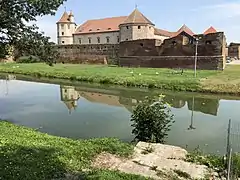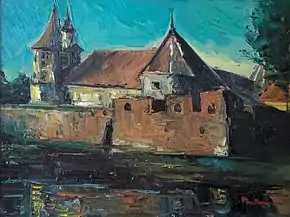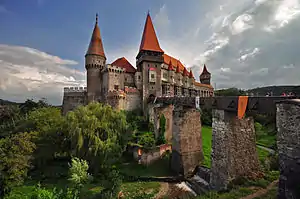Făgăraș Citadel
Făgăraș Citadel (Romanian: Cetatea Făgărașului, Hungarian: Fogarasi vár, German: Fogarascher Burg) is a historic monument in Făgăraș, Brașov County, Romania.
| Făgăraș Citadel | |
|---|---|
Cetatea Făgărașului | |
 Făgăraș Citadel Side View | |
 Location within Romania | |
| Former names | Cetatea Mihai Viteazul |
| General information | |
| Type | Citadel |
| Location | |
| Country | |
| Coordinates | 45°50′42.882″N 24°58′25.896″E |
| Construction started | 1310[1] |
| Website | |
| cetateafagarasului | |
The construction of the fortress started in 1310, on the site of a wooden fortification with earth ramparts from the 12th century. Archeological research shows that the old fortification was violently destroyed around the middle of the 13th century, presumably in connection with the Mongol invasion of 1241. Located halfway between Brașov and Sibiu and close to Wallachia, the Făgăraș Citadel provided a defensive position against possible incursions into south-eastern Transylvania.[2]
In 1526, Ștefan Mailat consolidated the citadel, doubling the thickness of the walls. In 1541, the Ottomans attacked the fortress and captured Mailat, who died in captivity at Yedikule Fortress in Istanbul.[3] Gáspár Bekes, owner of the citadel between 1567 and 1573, constructed the moat around the fortress, the excavated earth being used to strengthen the inner part of the walls. During the time of Stephen VIII Báthory (voivode of Transylvania from 1571 to 1586) and Balthasar Báthory (lord of the fortress from 1588 to 1594), the first bastion was constructed in the south-eastern corner of the outer defensive ring.[2] In 1599, Michael the Brave occupied Făgăraș Citadel and sheltered there his family and the royal treasure.[3] In the 17th century, Prince Gabriel Bethlen gave it priority over Alba Iulia in modernizing the fortifications, while Michael I Apafi transformed it, due to its strengthened position, into a princely residence.[2]
From 1948 to 1960, the fortress was used as a prison for those opposed to the communist regime,[3] and to members of the police and Siguranța Statului from the interwar period, including generals Vasile Zorzor, Gheorghe Liteanu, and Emanoil Leoveanu. In all, some 5,000 people were detained at this location, many of whom were subjected to torture. Cold, hunger and lack of any form of medical care were the causes of a large number of deaths among detainees.[4] According to researchers, either 161[5] or 166[4] inmates were officially declared to have died in this prison, though ex-detainees put the number much higher.[5]
Between 1965 and 1977 restoration work was carried out. Currently, the citadel functions as a museum, housing various artifacts.[3]

Notes
- "Fagaras Online - Istoria incepe aici". fagarasonline.ro. Retrieved 10 August 2011.
- "Istoria Cetății". cetateafagarasului.com (in Romanian). Retrieved September 30, 2020.
- "Cetatea Făgărașului, Făgăraș, Brașov". ibrasov.ro (in Romanian). Retrieved September 26, 2020.
- "Penitenciarul Făgăraș – Scurt istoric" (PDF). iiccr.ro (in Romanian). Retrieved September 26, 2020.
- "Cum mureau deținuții din Cetatea Făgăraș, fostă închisoare comunistă". europafm.ro (in Romanian). February 13, 2018. Retrieved September 26, 2020.




